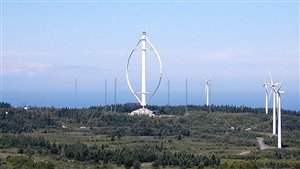Interest in renewable wind-generated electricity has been growing exponentially around the world, By far the most common design now is a 3-blade horizontal axis design on a tall mast.
However another design option is the vertical axis wind turbine (VAWT). There are a wide variety of such designs.
Engineer Glen Lux of Saskatoon, has been working on his design since 2002, and now his latest prototype has been recognized by the prestigious NASA Tech Briefs magazine.
This evening in New York he will getting the “sustainable technologies” award from the design-engineering magazine.

Years ago, engineers thought the vertical axis design was the better option than horizontal blades.
Instead of having the turbine mounted high up on the mast as is common now with horizontal axis concepts, a vertical axis turbine is located at the bottom at ground level.
They also do not need additional mechanisms to point them into the wind as is the case with horizontal designs.
Maintenance is also easier with VAWT’s as all major components are at ground level.
One of the drawbacks however, is that they are necessarily closer to ground level where wind strength is generally reduced. Also the mechanical loads generated on the blades vary greatly during each cycle creating stress on components..
In the seventies to the 90’s several experimental VAWT’s were installed in Canada. None are commercially operational now, including the largest one in the world. At 110 meters tall it is located in Cap Chat, Gaspe, Quebec and had operated commercially from 1988 to 1993
Lux says of these previous designs, “They couldn’t keep it together, it has resonance problems, vibrations, torque ripples, things like that.” He says, ” I just used some engineering skills and some intuition and a little bit of luck, and I came up with a design that I thought was hugely beneficial.”
He hopes that the NASA award will now attract industry attention to his new design.







For reasons beyond our control, and for an undetermined period of time, our comment section is now closed. However, our social networks remain open to your contributions.